NVIDIA launches Jetson Thor robotics computers for physical AI systems
Introduction & Market Context
Dana Gas (ADX:DANA) presented its financial results for the first half of 2025 on August 12, showcasing the company’s ability to maintain profitability despite challenging market conditions. The Middle East-focused energy company reported a slight increase in net profit despite lower production volumes in Egypt and softer commodity prices, highlighting its operational resilience and strategic focus on efficiency.
The company’s stock closed at 0.795 on August 22, trading between its 52-week range of 0.622 to 0.826, indicating relatively stable market performance amid the mixed operational results.
Executive Summary
Dana Gas reported a 1% year-over-year increase in net profit to $73 million for H1 2025, despite a 10% decline in revenue to $171 million. This performance was primarily driven by stronger pricing in Egypt, higher production quantities in the Kurdistan Region of Iraq (KRI), lower depreciation charges, and reduced finance costs.
The company’s production profile showed significant regional divergence, with KRI operations increasing output by 3% year-over-year to 38,550 barrels of oil equivalent per day (boepd), while Egypt experienced a 29% decline to 12,450 boepd due to natural field declines.
As shown in the following chart of the company’s latest earnings update:
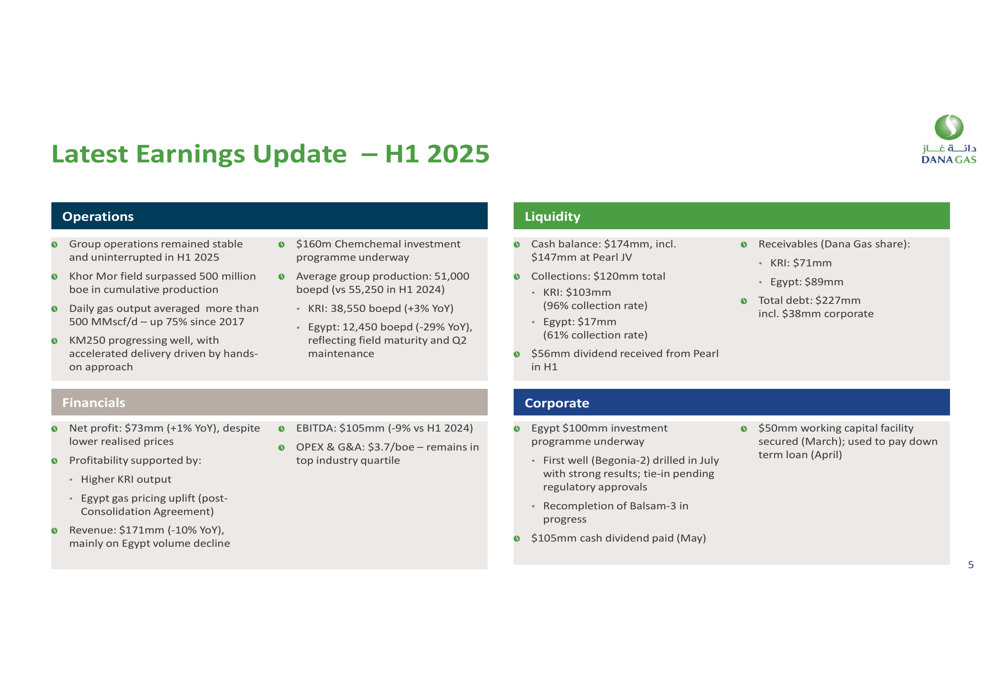
Quarterly Performance Highlights
Dana Gas maintained a solid cash position of $174 million at the end of H1 2025, supported by $120 million in collections ($103 million from KRI and $17 million from Egypt) and a $56 million dividend received from Pearl in H1. The company’s total debt stood at $227 million, reflecting its continued focus on maintaining low corporate leverage.
The Khor Mor field in KRI reached a significant milestone, surpassing 500 million barrels of oil equivalent in cumulative production. Daily gas output remained strong, exceeding 500 million standard cubic feet per day (MMscf/d), despite a temporary reduction due to planned maintenance in April.
The following chart illustrates the production breakdown across regions:
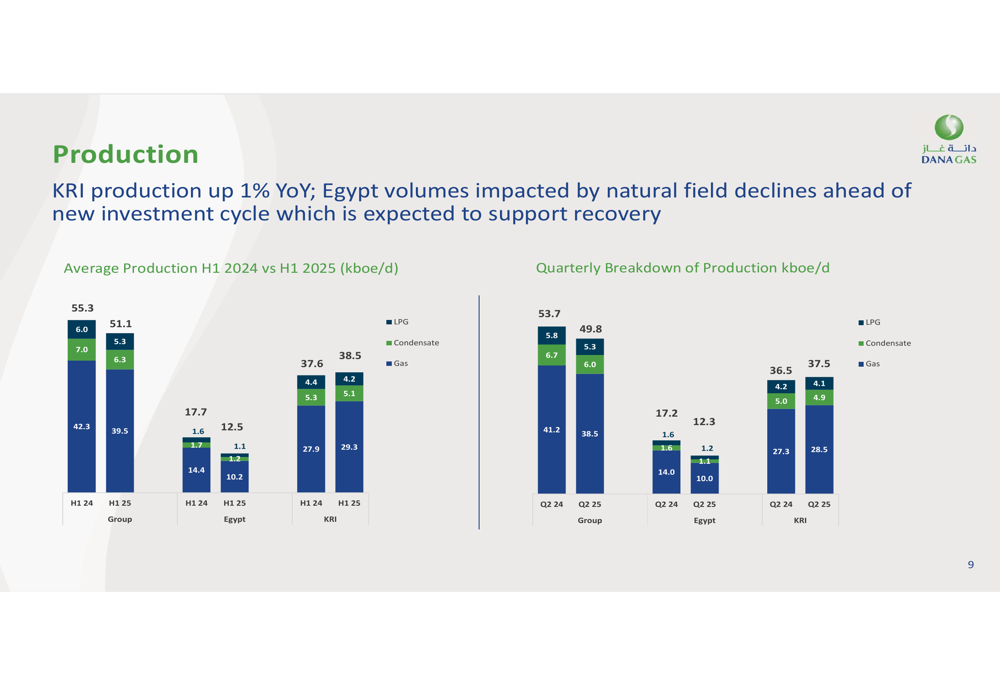
Realized prices remained relatively stable year-over-year, with condensate prices holding steady at $45 per barrel despite fluctuations in the broader market. The company benefited from an uplift in Egypt gas pricing and stable LPG prices, which helped protect margins.
The price stability across different products and regions is illustrated in this chart:
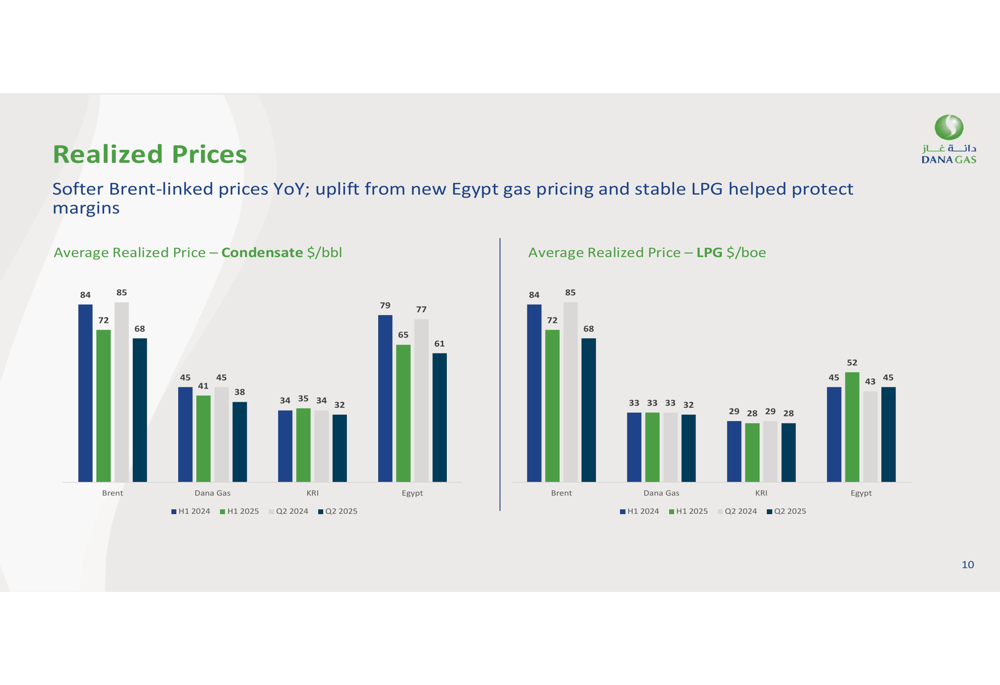
Detailed Financial Analysis
Revenue for H1 2025 declined 10% year-over-year to $169 million, primarily impacted by lower production volumes in Egypt and softer commodity prices. This decline was partially offset by higher production volumes in the KRI.
The following chart breaks down revenue by region and product type:

Despite the revenue decline, Dana Gas managed to increase its net profit by 1% to $73 million, although gross profit decreased slightly from $94 million to $90 million, and EBITDA fell 9% from $115 million to $105 million.
The company’s profit performance across different metrics is illustrated here:
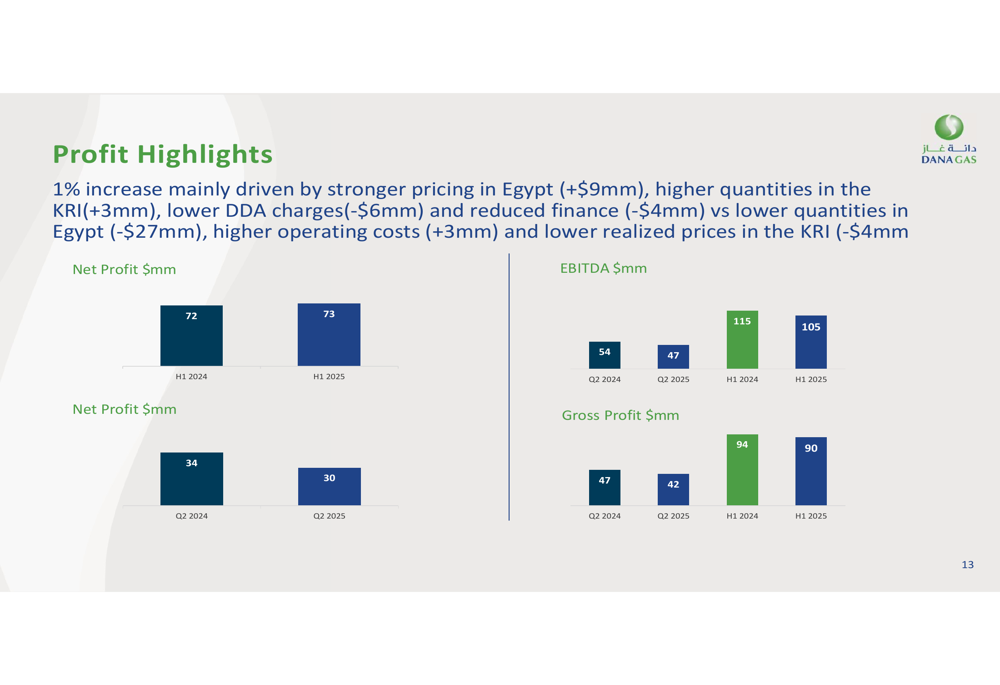
Capital expenditure increased as the company ramped up investment in the KM250 project in KRI and accelerated its drilling program in Egypt. Despite these investments, Dana Gas maintained efficient operational and administrative costs, with OPEX and G&A remaining within the top quartile at $3.75/boe.
The evolution of the company’s capital and operational expenditures is shown in this chart:
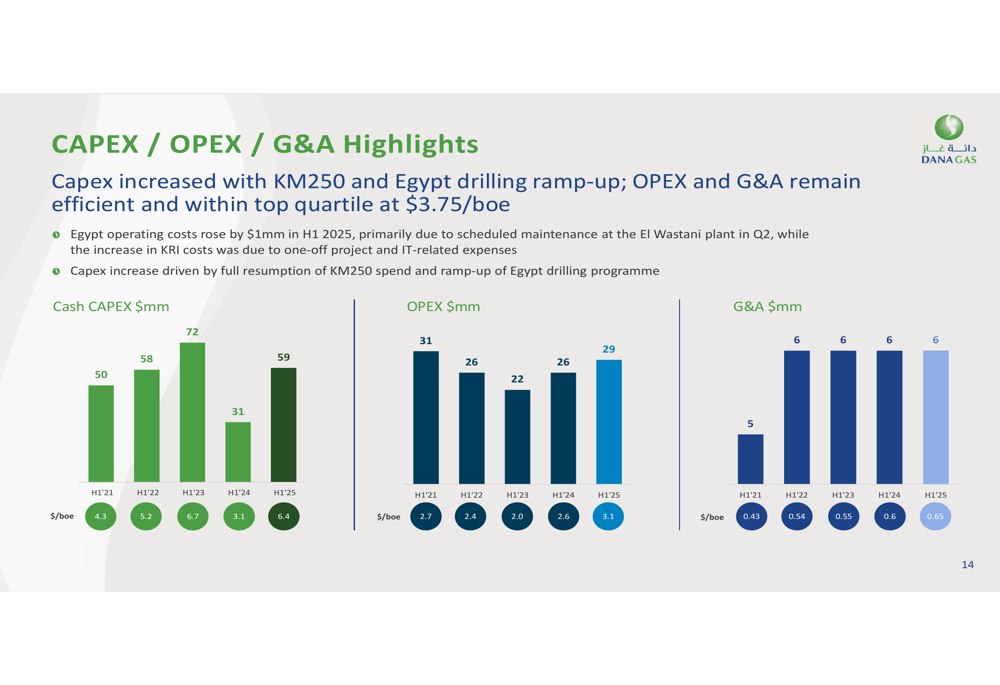
Dana Gas has continued to strengthen its balance sheet, maintaining low corporate leverage while pursuing strategic investments. The company’s borrowing has decreased significantly since 2017, as illustrated in the following chart:
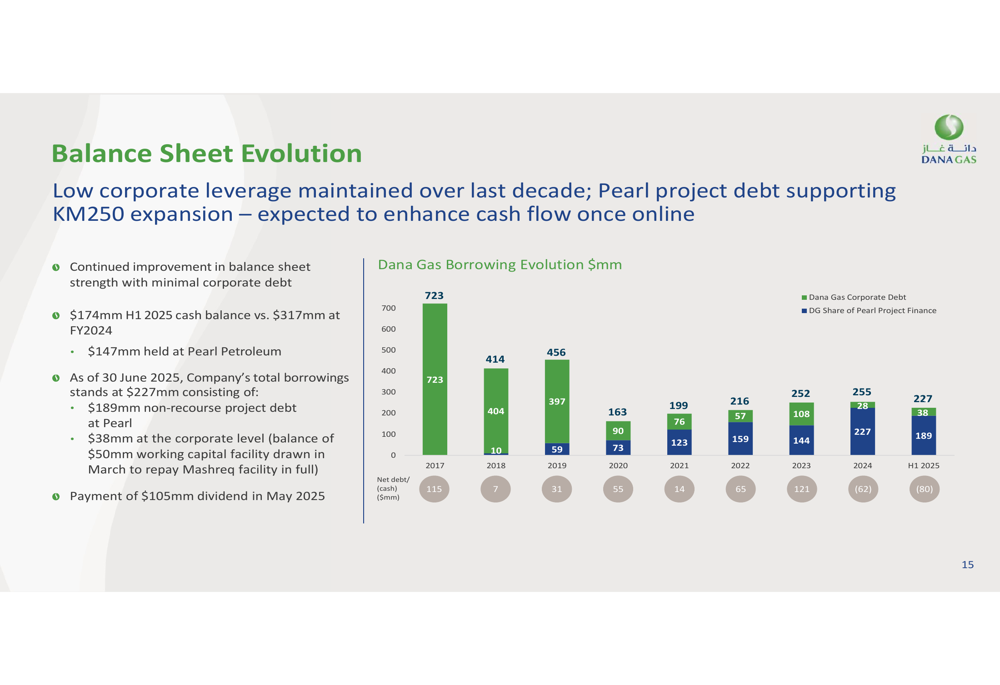
Strategic Initiatives
Dana Gas is advancing two major investment programs that are expected to drive future growth. In the KRI, the $160 million Chemchemal investment program is underway, targeting early production of up to 75 MMscf/d. The KM250 project is progressing well and remains on an advanced schedule. Once online, KM250 will add 250 MMscf/d of processing capacity.
In Egypt, the company launched a $100 million, two-year investment program following the signing of the Consolidated Concession Agreement in 2024. This program aims to drill 11 wells and is expected to add 80 billion cubic feet in gas recovery, delivering over $1 billion in energy cost savings for Egypt’s economy.
The Begonia-2 well was successfully drilled in July, confirming 9 billion cubic feet in reserves with expected output of 5 MMscf/d. Additionally, the recompletion of Balsam-3 is underway, with estimated reserves of 4 billion cubic feet and anticipated production of 3 MMscf/d.
Forward-Looking Statements
Management has outlined several priorities for the coming periods, including:
1. Delivering the KM250 project ahead of schedule
2. Continuing execution of the Egypt investment program
3. Ensuring timely payments from government partners
4. Maintaining sustainable dividend payments
5. Exploring new markets and geographies
The company’s management priorities and key takeaways are summarized in this slide:
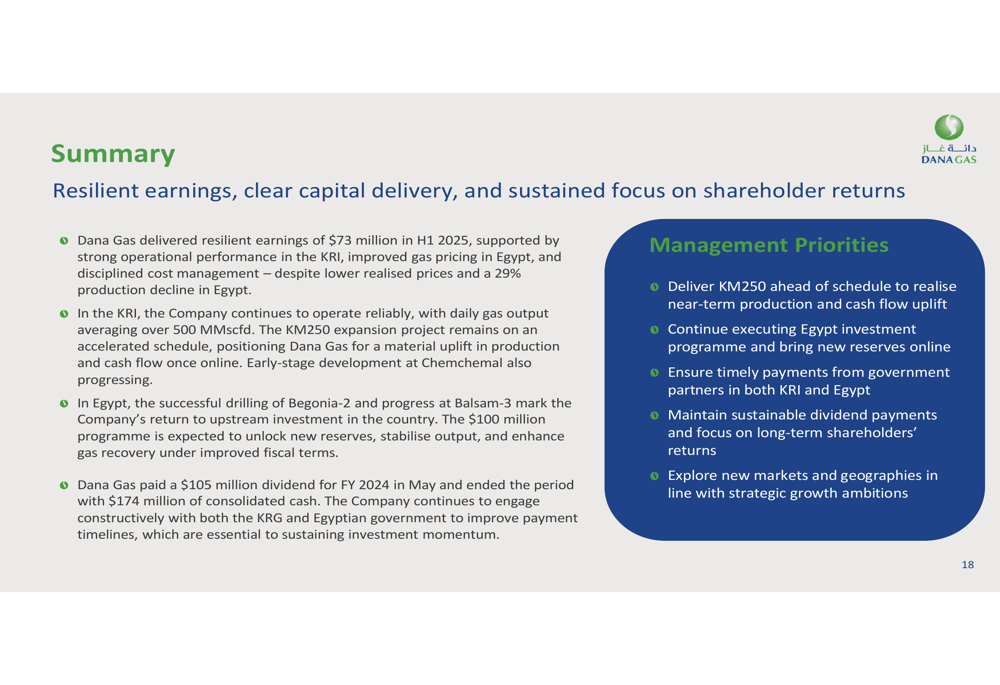
Dana Gas paid a $105 million cash dividend in May 2025, demonstrating its commitment to shareholder returns despite the challenging operational environment. The company also secured a $50 million working capital facility in March, providing additional financial flexibility to support its strategic initiatives.
Timely payments from government partners remain crucial for sustaining investments and operational momentum. At the end of H1 2025, receivables stood at $71 million in KRI and $89 million in Egypt, highlighting the ongoing challenge of managing collections in the regions where Dana Gas operates.
Full presentation:
This article was generated with the support of AI and reviewed by an editor. For more information see our T&C.
